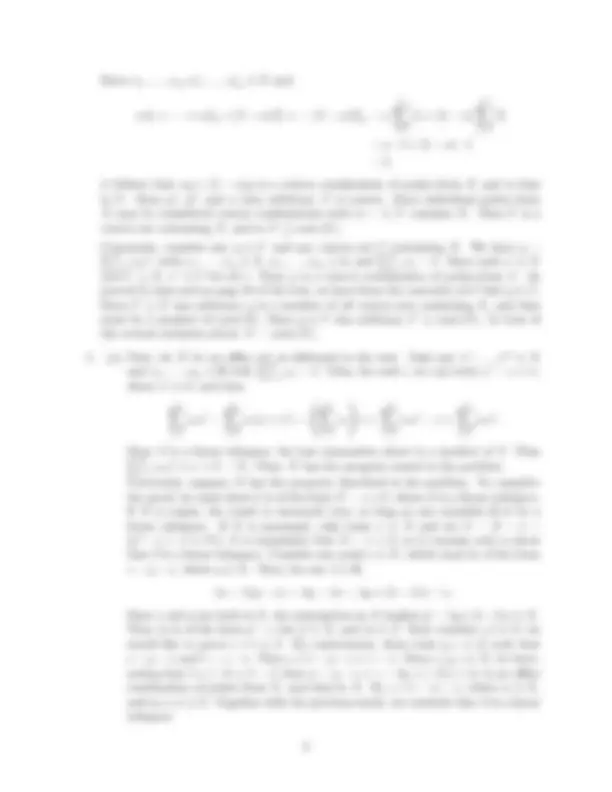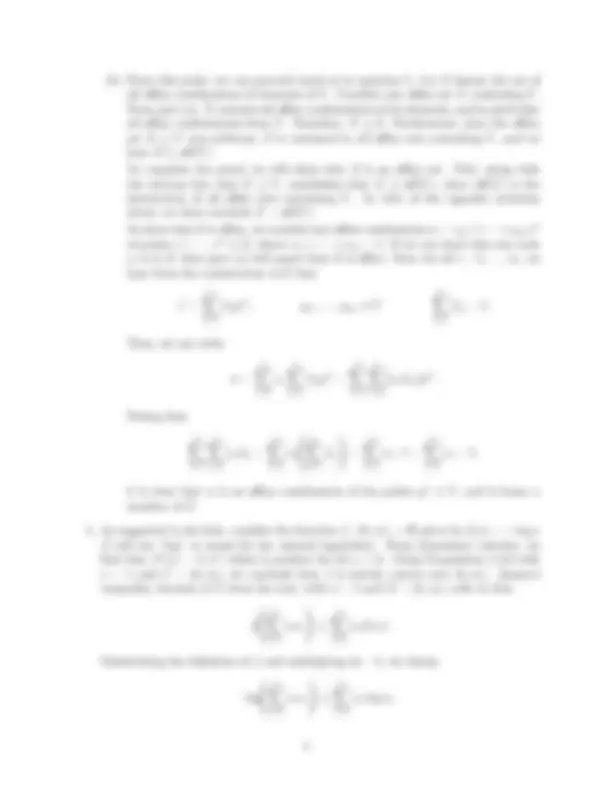





Study with the several resources on Docsity

Earn points by helping other students or get them with a premium plan


Prepare for your exams
Study with the several resources on Docsity

Earn points to download
Earn points by helping other students or get them with a premium plan
Community
Ask the community for help and clear up your study doubts
Discover the best universities in your country according to Docsity users
Free resources
Download our free guides on studying techniques, anxiety management strategies, and thesis advice from Docsity tutors
Material Type: Assignment; Class: 711 - SEL TOPICS OPER RES; Subject: OPERATIONS RESEARCH; University: Rutgers University; Term: Spring 2009;
Typology: Assignments
1 / 5

This page cannot be seen from the preview
Don't miss anything!




Spring 2009 Rutgers University Prof. Eckstein
αz^1 + (1 − α)z^2 = αλx^1 + (1 − α)λx^2 = λ
αx^1 + (1 − α)x^2
Since αx^1 + (1 − α)x^2 by convexity of C, αz^1 + (1 − α)z^2 is of the form λx for x ∈ C, and is thus contained in λC. Since z^1 ,z^2 , and α were arbitrary, λC is convex. Now consider any λ 1 , λ 2 > 0. We start by showing that if z^1 ∈ λ 1 C and z^2 ∈ λ 2 C, then we must have z^1 + z^2 ∈ (λ 1 + λ 2 )C. By construction, we have z^1 = λ 1 x^1 and z^2 = λ 2 x^2 , where x^1 , x^2 ∈ C. We note that by convexity of C, ( λ 1 λ 1 + λ 2
x^1 +
λ 2 λ 1 + λ 2
x^2 ∈ C
If we multiply this vector by (λ 1 + λ 2 ), we obtain λ 1 x^1 + λ 2 x^2 = z^1 + z^2 , so therefore z^1 +z^2 ∈ (λ 1 +λ 2 )C. Since z^1 ∈ λ 1 C and z^2 ∈ λ 2 C were arbitrary, we have λ 1 C +λ 2 C ⊆ (λ 1 + λ 2 )C. On the other hand, if we pick any point z ∈ (λ 1 + λ 2 )C, it must be of the form z = (λ 1 + λ 2 )x, for x ∈ C, and can be written z = λ 1 x + λ 2 x, meaning it is in λ 1 C + λ 2 C. Thus (λ 1 + λ 2 )C ⊆ λ 1 C + λ 2 C, and in view of the opposite inclusion proved above λ 1 C + λ 2 C = (λ 1 + λ 2 )C Counterexamples for nonconvex C are very simple. In R^1 , consider C = { 0 , 1 }, λ 1 = 1, and λ 2 = 2. Then λ 1 C + λ 2 C = { 0 , 1 , 2 , 3 }, but (λ 1 + λ 2 )C = { 0 , 3 }. (Notice that the proof of (λ 1 + λ 2 )C ⊆ λ 1 C + λ 2 C above did not use convexity, so that remains true.)
αf (x) + (1 − α)f (y) = α(〈a, x〉 + b) + (1 − α)(〈a, y〉 + b) = α〈a, x〉 + (1 − α)〈a, y〉 + αb + (1 − α)b = 〈a, αx + (1 − α)y〉 + b = f (αx + (1 − α)y).
Conversely, consider any function f obeying (1). Note that I did not specify the range of α for which (1) holds. It turns out that even if we suppose that (1) holds only for α ∈ [0, 1], we can immediately deduce that it holds for all α ∈ R. Suppose we have
z = αx + (1 − α)y for α > 1. We can rearrange this equation into αx = z + (α − 1)y and divide by α to obtain x =
α
z +
(α− 1 α
y. From (1) with the substitution α ← 1 /α ∈ [0, 1], we then obtain
f (x) =
α
f (z) +
(α− 1 α
f (y),
which we can algebraically manipulate into f (z) = αf (x) + (1 − α)f (y), even though α > 1. A similar technique applies if α < 0: we write y =
1 −α
z +
( (^) −α 1 −α
x, apply (1), and then apply a reverse series of algebraic manipulations. Thus, we may consider (1) to hold for α ∈ R. With this in mind, set g(x) = f (x) − f (0). We show that g : Rn^ → R must be a linear form. For any λ ∈ R, we have
g(λx) = f (λx) − f (0) = f (λx + (1 − λ)0) − f (0) = λf (x) + (1 − λ)f (0) − f (0) [by (1)] = λf (x) − λf (0) = λg(x).
Now take any x, y ∈ Rn. We then observe that
g(x + y) = g
2 x^ +^
1 2 y
= 2g
2 x^ +^
1 2 y
[since g(λx) = λg(x)] = 2
2 g(x) +^
1 2 g(y)
[by (1)] = g(x) + g(y).
So g is a linear functional. In Rn, this means that we must have g(x) = 〈a, x〉 for some a ∈ Rn.^1 Setting b = f (0), we obtain from g(x) = f (x) − f (0) that f (x) = g(x) + f (0) = 〈a, x〉 + b.
y =
∑^ m
i=
βixi y′^ =
∑^ m′
i=
β i′x′ i
where β 1 ,... , βm, β 1 ′,... , β′ m′ ≥ 0, x 1 ,... , xm, x′ 1 ,... , x′ m′ ∈ X,
∑m ∑ i=1^ βi^ = 1, and m′ i=1 β ′ i = 1. We then write αy + (1 − α)y′^ = αβ 1 x^1 + · · · + αβmxm^ + (1 − α)β′ 1 x′ 1 + · · · (1 − α)β m′′ x′ m′. (^1) For those of you familiar with infinite-dimensonal spaces, this result is also true in any Hilbert space by
the famous Riesz representation theorem. It may fail in more exotic infinite-dimensonal spaces.
(b) From this point, we can proceed much as in question 3. Let Z denote the set of all affine combinations of elements of Y. Consider any affine set X containing Y. From part (a), X contains all affine combinations of its elements, and in particular all affine combinations from Y. Therefore, X ⊇ Z. Furthermore, since the affine set X ⊇ Y was arbitrary, Z is contained in all affine sets containing Y , and we have Z ⊆ aff(Y ). To complete the proof, we will show that Z is an affine set. This, along with the obvious fact that Z ⊇ Y , establishes that Z ⊇ aff(Y ), since aff(Y ) is the intersection of all affine sets containing Y. In view of the opposite inclusion above, we then conclude Z = aff(Y ). To show that Z is affine, we consider any affine combination w = α 1 z^1 +· · ·+αmzm of points z^1 ,... , zm^ ∈ Z, where α 1 + · · · + αm = 1. If we can show that any such w is in Z, then part (a) will assert that Z is affine. Now, for all i = 1,... , m, we have from the construction of Z that
zi^ =
∑^ ni
j=
βij yij^ , yi 1 ,... , yini ∈ Y
∑^ ni
j=
βij = 1.
Thus, we can write
w =
∑^ m
i=
αi
∑ni
j=
βij yij^ =
∑^ m
i=
∑^ ni
j=
(αiβij )yij^.
Noting that
∑^ m
i=
∑^ ni
j=
αiβij =
∑^ m
i=
αi
( (^) ni ∑
j=
βij
∑^ m
i=
αi · 1 =
∑^ m
i=
αi = 1,
it is clear that w is an affine combination of the points yij^ ∈ Y , and is hence a member of Z.
f
( (^) m ∑
i=
αixi
∑^ m
i=
αif (xi).
Substituting the definition of f and multiplying by −1, we obtain
log
( (^) m ∑
i=
αixi
∑^ m
i=
αi log xi.
Applying the monotonic function ex^ to both sides of this inequality produces
∑^ m
i=
αixi ≥
∏^ m
i=
xα i i,
which is equivalent to the desired result. In the construction of Jensen’s inequality, it can also be seen that if f is strictly convex, then the inequality will be strict unless x 1 = · · · = xm.